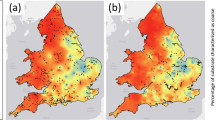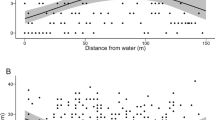Abstract
On the Atlantic coast of Canada, Semibalanus balanoides (L.) is widely distributed in the mid-intertidal zone, whereas in the Gulf of St. Lawrence, this species is mostly limited to crevices. We tested the hypothesis of regional differences in microhabitat selection by barnacle larvae at settlement in 1984 and 1985 at St. Andrews, New Brunswick, Canada. Since larvae settle in microhabitats already colonized by adults, the relative influence of settled barnacle density and of different scales of substratum heterogeneity on settlement were evaluated experimentally at Capucins, Québec, (Gulf of St. Lawrence) and at St. Andrews, New Brunswick (Atlantic coast). On a large scale (>10 cm deep crevices) of heterogeneity, results show that, in the Gulf, cypris larvae settled nearly exclusively (93%) in natural crevices rather than on adjacent horizontal surfaces. On the Atlantic coast, settlement was more important outside than inside of crevices, when the substrata were either natural or artificial. This result is unique and contrasts sharply with all known reports on barnacle settlement in relation to surface contour. The influence of barnacle density on settlement was greater than that of large scale heterogeneity. On a small scale (<1.5 cm deep cracks), the presence of conspecifics had a stronger effect on settlement than heterogeneity in both regions. Field observations showed a relationship between larval settlement density and percentage of adult cover. Settlement increased up to 22 or 30% (Gulf and Atlantic coast) of adult cover and decreased afterwards. The results confirm the hypothesis of larval selection for cryptic habitats in the Gulf and the opposite behaviour (preferences for horizontal surfaces) on the Atlantic coast. This microhabitat selection is apparent at large scales of heterogeneity, whereas at small scales, the presence of conspecifics is the predominant factor.
Similar content being viewed by others
Literature cited
Barnes, H.: Surface roughness and the settlement of Balanus balanoides (L.). Arch. Soc. Zoo. bot. fenn. Vanamo 10, 164–168 (1956)
Bergeron, P. and E. Bourget: Shore topography and spatial partitioning of crevice refuges by sessile epibenthos in an ice disturbed environment. Mar. Ecol. Prog. Ser. 28, 129–145 (1986)
Bourget, E., D. Archambault et P. Bergeron: Effet des propriétés hivernales sur les peuplements épibenthiques intertidaux dans un milieu subarctique, l'estuaire du Saint-Laurent. Nat. can. 112, 131–142 (1985)
Brault, S. and E. Bourget: Structural changes in an estuarine subtidal epibenthic community: biotic and physical causes. Mar. Ecol. Prog. Ser. 21, 63–73 (1985)
Bousfield, E. L.: The distribution and spawning seasons of barnacles on the Atlantic Coast of Canada. Bull. natl Mus. Can. 132, 112–154 (1953)
Canadian Hydrographic Service: Canadian tide and current tables, Vol. 1. Atlantic Coast and Bay of Fundy and Vol. 3. St. lawrence and Saguenay rivers. Ottawa: Fisheries and Oceans 1985
Connell, J. H.: The influence of competition, predation by Thais lapillus, and other factors on natural populations of the barnacle Balanus balanoides. Ecol. Monogr. 31, 61–104 (1961)
Crisp, D. J.: Territorial behaviour in barnacle settlement. J. exp. Biol. 38, 429–446 (1961)
Crisp, D. J.: Factors influencing the settlement of marine invertebrate larvae. In: Chemoreception in Marine Organisms, pp 177–265. Ed. by P. T. Grant and A. M. Mackie. New York, London: Academic Press 1974
Crisp, D. J. and H. Barnes: The orientation and distribution of barnacles at settlement with particular reference to surface contour. J. Anim. Ecol. 23, 142–162 (1954)
Crisp, D. J. and P. S. Meadows: The chemical basis of gregariousness in cirripedes. Proc. R. Soc. B 156, 500–520 (1962)
Crisp, D. J. and P. S. Meadows: Absorbed layers: the stimulus to settlement in barnacles. Proc. R. Soc. B 158, 364–387 (1963)
Dahl, A. L.: Surface area in ecological analysis: quantification of benthic coral-reef algae. Mar. Biol. 23, 239–249 (1973)
Doyle, R. W.: Settlement of planktonic larvae: a theory of habitat selection in varying environments. Am. Nat. 109, 113–126 (1975)
Gabbott, P. A. and V. N. Larman: Electrophoretic examination of partially purified extracts of Balanus balanoides containing a settlement inducing factor. In: Fourth Eur. Mar. Biol. Symp., pp 143–153. Ed. by D. J. Crisp. Cambridge: Cambridge University Press 1971
Gregg, J. H.: Replication of substrate detail by barnacles and some other marine organisms. Biol. Bull. mar. biol. Lab., Woods Hole 94, 161–168 (1948)
Hudon, C., E. Bourget and P. Legendre: An integrated study of the factors influencing the choice of the settling site of Balanus crenatus cyprid larvae. Can. J. Fish. aquat. Sci. 40, 1186–1194 (1983)
Ihnen, L. A. and J. H. Goodnight: The NLIN procedure. In: SASR user's guide: statistics. 5th ed., pp 575–606. Cary, NC.: SAS Institute Inc. 1985
Kirk, R. E.: Experimental design: procedures for the behavioral sciences, 2nd ed., 911 pp. Monterey, CA.: Brooks/Cole Publishing Co. 1982
Knight-Jones, E. W.: Laboratory experiments on gregariousness during setting in Balanus balanoides and other barnacles. J. exp. Biol. 30, 584–598 (1953)
Knight-Jones, E. W.: The gregarious settling reaction of barnacles as a measure of systematic affinity. Nature, Lond. 174, 266 (1955)
Knight-Jones, E. W. and D. J. Crisp: Gregariousness in barnacles in relation to the fouling of ships and to anti-fouling research. Nature, Lond. 171, 1109 (1953)
Knight-Jones, E. W. and J. P. Stevenson: Gregariousness during settlement in the barnacle Elminius modestus Darwin. J. mar. biol. Ass. U.K. 29, 281–297 (1950)
Larman, V. N. and P. A. Gabbott: Settlement of cyprid larvae of Balanus balanoides and Elminius modestus induced by extracts of adult barnacles and other marine animals. J. mar. biol. Ass. U.K. 55, 183–190 (1975)
Le Tourneux, F. and E. Bourget: The importance of physical and biological settlement cues used at different spatial scales by the larvae of Semibalanus balanoides. Mar. Biol. (in press)
Moyse, J. and E. Hui: Avoidance by Balanus balanoides cyprids of settlement on conspecifics adults. J. mar. biol. Ass. U.K. 61, 449–460 (1981)
Pomerat, C. M. and C. M. Weiss: the influence of texture and composition of surface on the attachment of barnacles and of other sedentary organisms. Biol. Bull. mar. biol. Lab., Woods Hole 91, 57–65 (1946)
Sokal, R. R. and F. J. Rohlf: Biometry, 2nd ed., 859 pp. San Francisco: Freeman and Co. 1981
Wethey, D. S.: Spatial pattern in barnacle settlement: day to day changes during the settlement season. J. mar. biol. Ass. U.K. 64, 687–698 (1984)
Yule, A. B. and G. Walker: The temporary adhesion of barnacle cyprids: effects of some differing surface characteristics. J. mar. biol. Ass. U.K. 64, 429–439 (1984)
Zar, J. H.: Biostatistical analysis, 620 pp. Englewood Cliffs, NJ: Prentice-Hall, Inc. 1974
Author information
Authors and Affiliations
Additional information
Communicated by R. W. Doyle, Halifax
Contribution to the programme of GIROQ (Groupe interuniversitaire de recherches océanographiques du Québec)
Rights and permissions
About this article
Cite this article
Chabot, R., Bourget, E. Influence of substratum heterogeneity and settled barnacle density on the settlement of cypris larvae. Mar. Biol. 97, 45–56 (1988). https://doi.org/10.1007/BF00391244
Accepted:
Issue Date:
DOI: https://doi.org/10.1007/BF00391244




